Public finance. Рубрика в журнале - Economic and Social Changes: Facts, Trends, Forecast
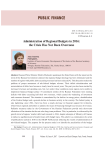
Administration of regional budgets in 2016: the crisis has not been overcome
Статья научная
Russian Prime Minister Dmitry Medvedev speaking in the State Duma with the report on the work of the Russian Government claimed that regional budget shortage has been eliminated and the number of regions with public debt exceeding revenues has been reduced [4]. This discussion makes the problem of proper assessment of sub-federal budgets relevant. Their deficit administration and accumulation of debts have become a steady trend in recent years. The past year has been marked by increased revenues and spending cuts, but even under these conditions most regions were unable to implement balanced budget policy: 54 constituent entities of the Russian Federation were running deficits with debts exceeding half their own revenues, which caused the weakening of investment and consumer demand. The situation is exacerbated by the decline in energy prices, destabilization of the Federal budget and a general decline in business activity in the country. The federal policy is also tightening: since 2014, there has been a steady decrease in financial support for territories, which forces regional authorities to address the issues of financing through local sources of revenues...
Бесплатно
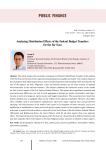
Analyzing distribution effects of the federal budget transfers for the Far East
Статья научная
The article analyzes the economic consequences of federal redistributive transfers for the regions of the Far East on the basis of two-regional computable general equilibrium model. The model is based on the assumption that regional government aims at maximizing their total spending which is limited by the size of the region’s tax base. Migration, trade and federal transfers are the main sources of regional interconnection in the national economy. The authors calibrated the linearized version of the model on data of nine regions of the Far Eastern Federal District. The regions have significant structural and macroeconomic differences not only in such aggregates as average per capita consumption and wages, but also in terms of average per capita income and budget expenditures. The researchers have found that federal transfers have a negligible effect on the welfare of the regional households. However, they affect other variables, such as consumption, employment, price level, wages, regional taxes and government spending. An initial increase in the welfare level causes an in-migration of labor resources, and a new equilibrium is established at a lower price level and per capita income in the recipient region. Moreover, a decrease in prices for local products is observed for the South Zone of the Far Eastern Federal District (Primorsky and Khabarovsk Krais, the Amur Oblast), while for all other regions there is an opposite effect. The research has shown that the regions of the Far East are characterized by different reactions and may have opposite effects with respect to the state budgetary policy measures in relation to these regions.
Бесплатно
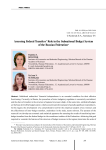
Assessing federal transfers' role in the subnational budget system of the Russian Federation
Статья научная
Subfederal authorities' financial independence is an essential condition for their effective functioning. Currently, in Russia, the procedure of inter-budgetary regulation is excessively centralized, and the share of transfers in the structure of regional revenues is high. At the same time, subfederal budgets arethebasiclevelofthebudgetsystem, whichconcentratesthemainpartofsociallysignificantexpenditures. In this regard, the development of a comprehensive tool for the empirical analysis of tax revenues and the effectiveness of inter-budget transfers, undertaken in the study, seems relevant. The purpose of the research is to develop an economic and statistical apparatus for assessing the results of transferring inter-budget transfers from the federal budget to the constituent entities of the Federation. Achieving this goal required to: consider the features of the structure of budget revenues in the regions; determine the scale of the territories' budget revenues heterogeneity, and give its quantitative assessment; identify the directions of the federal center's transfer policy; find out the nature of gratuitous transfers impact on the regional budgets. The novelty of the presented work is the creation of an economic and statistical apparatus for the study of the impact of federal budget policy on the region's public finance. This allowed us to characterize gratuitous transfers from the federal budget to the regions and determine whether there is a motivation to increase tax revenues in the Russian Federation's subjects or not. It is concluded that improving inter-budgetary relations should include measures to strengthen the Russian regions' tax potential, which is impossible if the stability of securing tax revenues is not ensured. Authorities need measures to prevent a direct correlation between actual and projected budget revenues and expenditures and the volume of transfers received from the federal budget to equalize budget security. The results of the research can be used to study the possibilities of improving budget policy in the direction of equalizing and stimulating the regions to strengthen their own revenue base.
Бесплатно
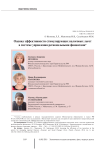
Assessing the efficiency of tax incentives in the system for managing regional finances
Статья научная
The paper analyzes existing techniques for assessing the effectiveness of tax incentives in the system for managing regional finances and reveals their advantages and disadvantages. It points out major conditions that determine the effectiveness of tax incentives at the regional level. The authors prove that assessing the effectiveness of tax incentives should focus, first, on identifying the relationship between the amounts of falling-out incomes and real economic benefits to the state and taxpayers that they entail; second, on determining the degree of correlation for this relationship; third, on adopting the decisions proceeding from the analysis of decisions concerning the extension of the incentive and its adjustment or possible abolition. The paper substantiates the conclusion that the effectiveness of tax incentives should be evaluated on the basis of three criteria: fiscal, economic and social. At that, the effectiveness of tax incentives at the regional level should be analyzed in several stages: calculation of budgetary, economic and social efficiency ratios; definition of the integral coefficient reflecting the total assessment of tax incentives efficiency; adoption of the decision about the appropriateness of introducing or further using the incentive, the decision being based on the calculations carried out previously...
Бесплатно
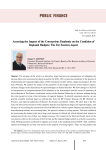
Статья научная
The purpose of the work is to determine major features and consequences of mitigating the adverse effects of a noneconomic shock caused by the 2020-2021 coronavirus pandemic in the process of implementing the regional budget policy of RF constituent entities within a large macroregion, the Far East of Russia. We analyze the impact of the pandemic on the budget revenues of Far Eastern regions, estimate changes in the dependence of regional budgets on federal transfers. We show changes in the level of transparency in intergovernmental fiscal relations in the macroregion and the extent of autonomy of the authorities of Far Eastern constituent entities of the Russian Federation in decision-making during the crisis period in terms of the formation of regional budgets. To identify statistical patterns, we use general scientific methods based on official data from the RF Federal Treasury, the RF Ministry of Finance, and regional authorities of Russia’s Far Eastern constituent entities. We show that in the Far East, the first and second waves of the epidemic had the most significant impact on regional budgets, and the pace of overcoming the coronavirus crisis was different in various regions. Regions specializing in the manufacturing industry are recovering faster; the process is slower in mining regions. The main condition for overcoming the budget crisis was a large-scale increase in federal aid, which allowed most regions to compensate for the loss of their own budget revenues. The impact of the third and fourth waves of the coronavirus crisis on the economy of the Far East and the regional budget sphere as a whole is assessed as weak. Mining industries continued to stagnate; as a result, in the analyzed period of 2020-2021, problems related to forming the tax base were noted in the majority of mining regions. Thus, we may predict that the state of regional budgets will depend more on the transfer support from the federal center. We reveal the absence of clear criteria in the provision of transfer support to the regions. Transparency of the aid provided to RF constituent entities has deteriorated during the pandemic crisis, which may lead to the emergence of adverse factors in regional development due to the desire of regional governments to lobby for special financial preferences from the federal center. The novelty of the research is due to the fact that we consider the aforementioned range of issues while comparing federal trends and the situation in the Far East under the increasing pressure of external noneconomic shocks caused by the lingering coronavirus pandemic. The materials of the article can be used in the educational sphere and in the work of state authorities at the federal and regional levels to improve budget policy.
Бесплатно
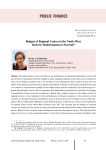
Budgets of regional centers in the north-west: tools for modernization or survival?
Статья научная
The paper opens a series of studies on the development of regional administrative centers. We put forward a hypothesizes that the budgetary policy regarding regional centers does not correspond to their current budget condition and is not focused on such development that would turn cities into the pillars of the balanced and harmonious spatial development of Russia. In this regard, the goal of the study is to conduct a comprehensive analysis of the budget system and the conditions of its functioning in regional administrative centers. We use economic and mathematical methods and reveal that the changes in geopolitical and geo-economic conditions in Russia had a negative impact on the budget systems of regional centers; it was manifested in the predominance of financial assistance in the structure of total revenues, in the stable dynamics of imbalance and in a decrease in the level of budget security of the population. We use official data of Rosstat and the Federal Treasury to find out key trends in the development of regional centers of the North-West of Russia since 2011. We conclude that the budgets of regional centers are trying to survive and are not ready to implement social transformation and promote economic growth. Based on this, we define major development directions for regional centers. The materials of the paper can be of use in the educational sphere, in the study of financial and economic disciplines; they can also be used by scientists as a basis for further research and by management bodies of various levels to substantiate management decisions. Further research will be devoted to the study of the effectiveness of management of the budget of the regional center, the level of debt burden and the state of intergovernmental fiscal relations.
Бесплатно
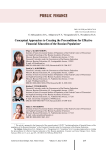
Статья научная
The global financial crisis that broke out in 2008 highlighted the problem of low levels of financial literacy among the population of different countries, and the response to this was the creation of national financial education systems where international economic organizations played the guiding and coordinating role. Russia also launched a joint project of the Ministry of Finance of the Russian Federation and the world Bank in 2011, and then adopted a Strategy to improve financial literacy of the population. However, despite the efforts and money spent, the level of the Russians' financial literacy and their trust in financial institutions remains low. The article presents conceptual approaches to creating the preconditions for effective financial education of Russian residents and describes the structural and functional model within which this can be implemented. The information base of the research is the data from Russian and international studies on financial literacy of the population and works devoted to their comparative analysis; the guidelines and analytical materials of international organizations; the results of an expert survey conducted by the authors with the participation of 136 experts from 30 regions of Russia. It is shown that effective financial education is impossible without an effective income policy, when the population has free money, and the need to dispose this money generates a practical interest in improving financial literacy. The second fundamental condition is the implementation of the “trust policy”, i.e. ensuring the operation of the state mechanism that does not allow the depreciation of citizens' savings and reliably protects their rights when interacting with financial institutions. Stability and predictability of economic development, refusal to impose excessive consumption standards on the population, physical accessibility of credit and financial institutions in small towns and villages, develop ment of information and communication infrastructure, and increasing the Russians' digital culture are important. The main components of financial education proper are described; the approaches to defining target groups for financial literacy training and selecting appropriate educational programs are proposed.
Бесплатно
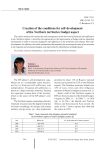
Creation of the conditions for self-development of the northern territories: budget aspect
Статья научная
The article analyzes the reasons for and consequences of the low level of financial self-sufficiency in the Northern regions, it describes the approaches to the improvement of budget and tax regulation mechanisms in order to increase budgetary self-sufficiency in the territories and enhance their self-development. In addition, the article substantiates the proposals for increasing the share of tax revenues in the regional and municipal budgets and improving the redistribution of budget funds.
Бесплатно
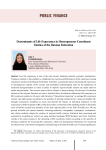
Determinants of life expectancy in heterogeneous constituent entities of the Russian Federation
Статья научная
Low life expectancy is one of the main factors hindering national economic development. Finding a solution to this problem is complicated by enormous differentiation of life expectancy among constituent entities of the Russian Federation. Therefore, assessing the factors increasing life expectancy in heterogeneous regions of the country and developing methodological tools for the application of territorial defragmentation in terms of policy to improve regional health systems are major tasks for public administration. The research aims to find a solution to these problems. On the basis of a detailed analysis of the relevant literature we form a statistical base of indicators influencing life expectancy in RF constituent entities for 10 years; with the help of “hierarchical clustering” we arrange RF constituent entities into eight groups according to the specifics of forming conditions for a long and healthy life; through econometric modeling we assess and identify the impact of individual indicators on life expectancy in different groups of RF constituent entities; on the basis of the modeling results we formulate areas of further research and priorities of the state regional policy in the field of health care. We use general scientific and special methods, including statistical, cartographic, typological, econometric, and cluster methods during the analysis of regional health systems. Statistical data processing and econometric modeling are carried out using statistical packages SPSS Statistics and Gretl. Scientific novelty of the study consists in the clustering of RF constituent entities according to the specifics of forming conditions for increasing life expectancy, which has fundamental importance for improving the effectiveness of territorial management and planning in the field of health care. Practical significance of the work is determined by the tasks of regional policy of Russia and its constituent entities in the sphere of increasing the life expectancy. The results of the study can be useful to the state regional authorities and local authorities for the formation of a set of measures to improve life expectancy.
Бесплатно
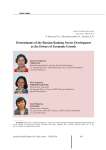
Determinants of the Russian banking sector development as the drivers of economic growth
Статья научная
The paper substantiates the relationship between the situation in the national banking sector and Russia's economy. Using the data provided by the Bank of Russia [8; 9; 10], Federal State Statistics Service [2], IBM SPSS Statistics software product, the authors have carried out a regression-correlation analysis of the main indicators of the Russian banking sector in 2005-2015 and GDP. It has been found that there is the strongest positive correlation between GDP and aggregate banking risks and also the profit of credit institutions; the correlation between GDP and aggregate financial result of the banking sector is weaker; the return on equity has no significant relationship with major indicators of banking activities, except for a moderate negative relationship with the aggregate value of regulatory capital; the return on equity in the Russian banking sector is affected adversely by subordinated debt in the structure of capital. In a stable economic situation (2005-2007, 2010-2013) the authors point out a correlation between capital and the profit of the banking sector; in a crisis situation (2008-2009, 2014-2015), there is a correlation between capital and the profit of profitable credit institutions alone...
Бесплатно
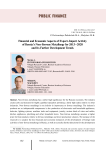
Статья научная
Non-ferrous metallurgy has a rather high significance for the Russian economy. The industry creates jobs and demand for highly qualified specialists providing a fairly high salary relative to other industries. Non-ferrous metallurgy is not inferior in importance to ferrous metallurgy. The industry’s products act as indispensable components in the production of electronics and household appliances, batteries, lighting systems, machine tools and equipment, jewelry, various kinds of wires and cables, kitchen appliances, plumbing and other household items. Non-ferrous metallurgy assumes a higher price for final products relative to ferrous metallurgy and lower production volumes. The purpose of the research is to analyze the key financial and economic indicators of the development of foreign trade activities of non-ferrous metallurgy in Russia, as well as to predict further directions for the development of trade turnover in the prevailing new economic conditions. The object of the study is foreign trade relations arising between the Russian Federation and foreign countries regarding the export and import of non-ferrous metals. We use methods such as structural (weight) and dynamic analysis, comparison, systematization, and forecasting. The information base is statistical data on the export-import activities of Russia’s non-ferrous metallurgy; Russian and foreign literature on the industry development; Rosstat statistics, as well as information from the annual reports of the largest Russian non-ferrous metallurgy corporations PJSC Rusal and PJSC Nornickel.
Бесплатно
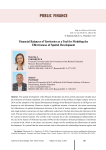
Financial balances of territories as a tool for modeling the effectiveness of spatial development
Статья научная
The spatial development of the Russian Federation has been actively discussed virtually since the formation of modern statehood. The institutionalization of the problem of single-industry towns in 2014 and the adoption of the Spatial Development Strategy of the Russian Federation in 2019 gave a new impetus to such discussions. However, despite a significant amount of research, the issues concerning the effectiveness of spatial development decisions at the level of macro-regions, urban agglomerations and single-industry towns have not been sufficiently worked out; this fact determines the relevance of the work. The aim of our study is to substantiate the tools for assessing the effectiveness of spatial development for various territorial entities. The novelty of the research lies in the methodological substantiation of the use of the System of National Accounts (SNA) for the formation of financial balances of territories at various levels, which in the future can become a single tool for modeling the effectiveness of spatial development. It is proved that the most accurate tool to determine the relationships between regions and evaluate the effectiveness of decisions for macroregions can be the creation of interregional input-output tables, for urban agglomerations the development of individual and combined financial balances of municipalities, for single-industry towns the development of tables for the formation, redistribution and use of financial resources, with the allocation of channels for the outflow/inflow of flows. The article, providing an example of the practical application of the proposed approaches, presents the financial balances of several single-industry towns of the Sverdlovsk Oblast for 2020 in the context of institutional sectors of the economy (“Corporations”, “Public Administration”, “Households”). According to the analysis of the data obtained, we see that the construction of financial balances made it possible to clearly identify the existing imbalances in the economic development of the territories: the Ural Mining and Metallurgical Company (UGMK) has a great influence on financial flows in Urban Okrug Verkhnyaya Pyshma; financial resources are being actively withdrawn from the Kamensk-Uralsky Urban Okrug by corporations and the population; financial balances in Severourasky Urban Okrug show a classic picture of a single-industry town with crisis phenomena. The findings of the study can be used to develop a full-fledged system for modeling the effects of spatial development of various territories of the Russian Federation.
Бесплатно
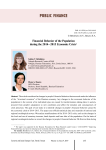
Financial behavior of the population during the 2014-2015 economic crisis
Статья научная
The article considers the changes in people’s financial behavior that occurred under the influence of the “structural recession” of the Russian economy. Any changes in the economic behavior of the population in the context of its individual types are caused by transformations taking place in society, proceed from people’s adaptation to new conditions and affect the duration and consequences of crisis processes. The goal of our study is to identify changes in people’s financial behavior caused by the economic crisis of 2014-2015. The paper uses official statistical data and materials of national and regional sociological surveys. We analyze manifestations of the 2014-2015 crisis, such as the changes in the level and use of monetary incomes, bank deposits and loan debt of the population. On the basis of regional sociological studies we reveal the changes in people’s financial behavior. We find out that during the crisis processes the growth rates of bank deposits and loan debt decreased, the structure of savings and credit purposes changed, and the violations in the regularity of loan payments became more frequent. In particular, at the regional level (in the Vologda Oblast), the share of inhabitants with savings has decreased significantly, the share of those who are saving money to use when they retire and the share of car loans have decreased; the share of savings for improving housing conditions, for recreation and travel, as well as the share of loans for urgent needs and unforeseen expenses have increased; the number of cases of overdue monthly payments on loans has increased. At the same time, some components of financial behavior turned out to be insensitive to the changing economic situation, among them - the reasons for refusal to form savings, the most common forms of accumulation, and the criteria for choosing a bank. We conclude that there are no mass deviant practices in the financial behavior of the population of the region in the crisis period; in general, people adapt to the changes that take place in the socio-economic situation. We recommend using the results of the monitoring studies of financial and other types of economic behavior in the activities of regional authorities in order to obtain timely information on current changes and make adequate management decisions.
Бесплатно
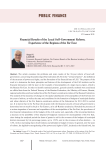
Financial results of the local self-government reform. Experience of the regions of the Far East
Статья научная
The article examines the problems and main results of the 30-year reform of local selfgovernment, concerning the positioning of the institution of LSG in the “vertical of power”, the definition of the structure of powers and rights, and the formation of the financial base of LSG. The purpose of the work is to determine the basic principles and features of the development of the LSG institute and its financial interaction with the state on the example of municipalities of a large macro-region, which is the Russian Far East. In order to identify statistical patterns, general scientific methods were used based on official data from the Federal Treasury of the Russian Federation, the Ministry of Finance, Rosstat, regional authorities and local authorities of the Far Eastern constituent entities of the Russian Federation. The analysis of the dynamics of changes in the spatial classification of municipalities of the Far East over the years of reform, as well as the state and conditions for the formation of budgets of municipal districts and urban districts of the Far Eastern constituent entities of the Federation for 2011-2019 is carried out. It is shown that in the Far East the situation with the financial security of local self-government is determined not so much by local or Far Eastern, as by all-Russian tendencies. Revealed the presence of a serious stagnation of revenues and expenditure of the municipalities of the Far East; the prevalence of low financial independence of the budgets of the civil society and, especially, of the municipal districts; a decrease in the possibility of free disposal of budgetary resources for municipalities of the Far East, since during the analyzed period the share of grants-in-aid in the revenues of the budgets of municipal districts decreased by 8.6 percentage points, up to 15.9%, and in the revenues of urban districts - to 1.8%, with an increasing share of subventions and subsidies in budget revenues. In general, over the years of reform, the legislative strengthening of the powers and rights of LSG, declared at the federal level, has not received adequate financial support in the region. Proposals for improving the financial component of the LSG reform in the framework of the evolutionary approach have been substantiated. It is shown that constitutional changes, while remaining formally neutral to LSGs, will require clarification of federal legislation for their implementation, which can give rise to a number of latent threats and undermine the principle of organizational isolation and financial independence of LSG bodies. The novelty of the research task is actualized by considering the aforementioned range of issues in comparison of federal trends and the situation in the macroregion under the conditions of changes in the Constitution of the Russian Federation and an increasing understanding of the need to strengthen the financial base of LSG. The materials of the article can be used in the educational sphere and in the activities of public authorities and LSG.
Бесплатно
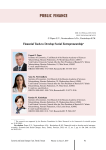
Financial tools to develop social entrepreneurship
Статья научная
Social entrepreneurship, being a relatively new activity for the Russian economy, requires the development of conditions and support mechanisms; this helps address social issues in society and also stimulates civic activity in this regard. Our paper classifies financial tools according to types of investors with different financial requirements, and analyzes the availability of these tools for the development of social entrepreneurship. We place special emphasis on mezzanine financing, social impact bonds, impact investing, and hybrid financing. In order to determine the availability of financial tools that are used to develop social entrepreneurship in Russia, we analyze financial statements of social entrepreneurs included in the catalog, formed by the Fund “Our Future”. The analysis used the coefficients of autonomy, current liquidity, profit (EBIT) and its growth rate in 2017. We have revealed that only nine of the considered organizations, which is less than 22%, meet the stated requirements and can apply for loans. Thus, we show that it is necessary to develop investment tools with lower financial requirements. Theoretical importance of our research findings consists in the fact that they expand theoretical and methodological provisions for studying social entrepreneurship in terms of systematization of financial tools used in international practice. The findings of our research are relevant in the practical aspect as well, because they help identify low availability of financial tools used in the Russian practice. The obtained data can be used to elaborate a strategy for development of this type of activity at different levels of management.
Бесплатно
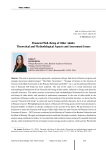
Financial well-being of older adults: theoretical and methodological aspects and assessment issues
Статья научная
The tasks to promote active ageing and a prosperous old age, laid down in Russia’s program and strategic documents (federal project “The Older Generation”, “Strategy of Actions in the Interests of Citizens of the Older Generation in the Russian Federation until 2025”, etc.), can be addressed effectively only if financial well-being has been achieved. The aim of the study is to reveal theoretical and methodological foundations of the financial well-being of older adults, reflected in foreign and domestic scientific discourse. The article presents a theoretical and methodological framework for the financial well-being of older adults, and provides its preliminary assessment in the case of older adults in the conditions of Russian reality. As a result of a critical analysis of the scientific literature, we show that the concept “financial well-being” is commonly used in foreign scientific discourse, but it is not widespread in Russian research. We highlight general aspects of financial well-being: good current financial situation; financial stability in relation to shocks; confidence in the security of the future. We put forward a set of indicators to assess the financial well-being of older adults based on data from the All-Russian Survey of Consumer Finance - 2022 (a survey conducted by the Ministry of Finance of the Russian Federation and the Bank of Russia). We apply sociological analysis methods (descriptive analysis, frequency distribution analysis using combination tables). It is revealed that older adults feel more prepared for possible financial shocks, which is facilitated by the orientation toward savings practices and low credit activity. We identify the following sore spots: older adults are more concerned about the likelihood of money shortage, and they also do not feel confident in the sufficient financial security of their future. At the end of the article, we outline promising areas for research.
Бесплатно
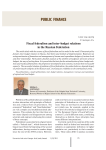
Fiscal federalism and inter-budget relations in the Russian Federation
Статья научная
The article deals with the essence of fiscal federalism and its model in the world. Characterized by features inter-budget relations in Russia, their forms and methods of implementation. Represents an acting mechanism of formation and management of income and expenditure budgets of various levels and their relationship. Particularly detailed analysis of the problem of budgetary provision of local budgets, the ways of solving them. It is proved that the basis for the rationalization of inter-budget relations and real fiscal federalism is the progressive development of its economy, increase their own taxable capacity. The successful solution of problems of fiscal federalism, the author believes, depends largely on preserving the integrity of the Russian state, increasing its credibility in the international arena.
Бесплатно
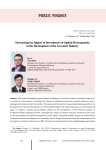
Статья научная
The article investigates uneven spatial development of livestock industry in Russia’s regions. It is caused by many factors, including the volume of attracted investments, human resources; and it endangers the food security of territories. The purpose of the study is to assess spatial heterogeneity in the development of the livestock industry in the Sverdlovsk Oblast. To achieve the goal, we set the following tasks: to conduct a spatial autocorrelation analysis of the development of the livestock industry in Sverdlovsk Oblast municipal entities, investigate the impact of human resources investments and costs on the development of spatial heterogeneity in the region’s livestock industry, assess the spatial effects of livestock industry development in territorial systems, design forecast scenarios for its development in the region’s municipal entities up to 2025. Having reviewed theoretical and methodological approaches to assessing spatial heterogeneity at the regional and municipal levels we find out that Russian and foreign researchers use a variety of methods. Their application does not contribute to the comprehensive assessment of spatial heterogeneity in the development of the livestock industry. To solve the problem, we propose a methodological approach, whose novelty consists in the comprehensive application of spatial autocorrelation analysis methods using various matrices of spatial weights, regression analysis using panel data and ARIMA modeling which, when combined, make it possible to determine the impact of investments and other factors on heterogeneity in the development of the livestock industry in the region’s municipalities and design a system of various forecast scenarios. The regression models we constructed have confirmed the differentiated impact of investments and human resources on spatial heterogeneity in the livestock sector in the Sverdlovsk Oblast and outlined the prospects for its development.
Бесплатно
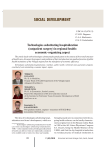
Formation of regional budget in crisis
Статья научная
As is known, in December 2009 Legislative Assembly enacted a law «On Regional Budget for 2010». The budget is formed by the conservative scenario, based on projected economic growth of 2.5%. The analysis of the main financial area of the law, conducted by ITSED RAS, showed that the current year will be a serious test of the regional budget system. The budget deficit of the Vologda region is the highest among the donors regions. It is 28%. Nevertheless, despite the tense situation, the reserves increase revenue and reduce costs in the area are available.
Бесплатно
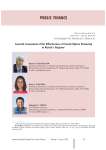
General assessment of the effectiveness of social sphere financing in Russia's regions
Статья научная
The paper presents an approach to assessing the effectiveness of social sphere financing (healthcare, education, housing and utilities sector) in regions of Russia. In the framework of the study, we test the following hypothesis: when the socio-economic situation in a region gets better, the effectiveness of social sphere financing in it reduces. The methodology for studying the effectiveness of social sphere financing in regions with different levels of socio-economic development is based on assessing the dependence of the dynamics of the indicators achieved by them and the amount of budget expenditures. To carry out the assessment, we select nine resulting indicators of the functioning of social sectors, taking into account the list of indicators for assessing the effectiveness of performance of executive authorities of constituent entities of the Russian Federation (the list was approved in November 2017 by the decree of the President of the Russian Federation) and on the basis of the presence of a statistical relation between them and the Human Development Index as a final indicator...
Бесплатно

